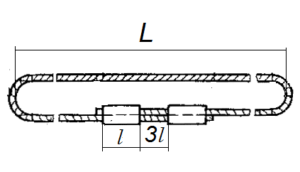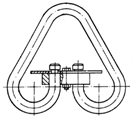
- Standard hoisting capacity *: from 0,4 up to 20,0 t
- Length: from 900 mm
- Methods of wire rope end splicing : pressing in aluminium bushing;
Basic information about rope slings
Steel wire rope slings are applied for fixing cargo to hooks of cargo lifting machinery and for moving heavy large-size cargo. Cargo is to be lifted with the aid of slings which match the mass and nature of hoisted cargo with due account of the number of sling legs and the angle of their inclination.
Advantages of rope slings:
high carrying capacity and flexibility;
have sufficient reliability and resistance to sharp dynamic loads, since the rope smooths them;
the destruction of the rope during operation does not occur suddenly, but gradually, which allows you to track the condition of the sling and timely remove them from operation.
effective work in a wide temperature range.
Rope slings are made according to the following regulatory and technical documentation:
DSTU B B.2.8-10-98;
TU U 29.2-22959884-002-2003;
TU U 28.7-22959884-012: 2005;
TU U 25.9-26209430-003: 2019.
Each sling is tested for compliance with the standards and is accompanied by a passport.
Types of rope slings
One-leg wire rope sling
 | ||||
СКП Eye-Eye | ВК Thimble and thimble | 1СК Eye – Hook | 1СК ring – hook | 1СК ring-ring |
Wire rope eye slings RES
 |  |
| Splicing | Pressing |
Multi-leg wire rope slings
 |  |  |
| 2СК | 3СК | 4СК |
Special purpose slings
 |  |  |  |
| 1СП | 2СП | 1СТ | 2СТ |
Loops are made by splicing or pressing
 |  |
| Eye (splicing) | Thimble in eye (splicing) |
 |  |
| Eye (pressing) | Thimble in eye (pressing) |
The slings are equipped with various main links and gripping bodies, depending on the purpose of the slings and the customer's wishes
Basic links
 |  |  |  |
| Link ОВ | Link ОВ2 | Link Т | Link РТ |
Gripping bodies
| Hook | Link ОВ | Shackle | Eye | Thimble |
Maximum safe workloads on rope slings taking into account cargo sling schemes:
The working load of a sling from a steel rope is affected by the angle between the legs of the sling. Lifting is prohibited if the angle between the legs of the sling is greater than 120 ° (if the angle is 120 °, then the permissible lifting capacity of the sling is reduced by 50% of the original).
| Type of sling
| СКП і 1СК | СКК | СКП | 2СК | 3СК и 4СК | ||||||||||
 |  |  |  |  |  |  | |||||||||
Sling hitch type | vertical | choker | vertical | choker | basket | basket | basket | basket | vertical | vertical | |||||
| Angle with vertical,° | 0 | 0 | 0
| 0 | 0 | 45° | 60° | 45° | 60° | 0 | 45° | 60° | 45° | 60° | |
Ratio. Rс | 1,0 | 0,8 | 2,0 | 1,6 | 4,0 | 2,8 | 2,0 | 1,4 | 1,0 | 2 | 1,4 | 1,0 | 2,1 | 1,5 | |
An example of calculating the carrying capacity of slings from a rope of one diameter, g/p, t | |||||||||||||||
| Rope Ø 15,0 mm | 2,0 | 1,6 | 4,0 | 3,2 | 8,0 | 5,6 | 4,0 | 2,8 | 2,0 | 4,0 | 2,8 | 2,0 | 4,2 | 3,0 | |
Operating temperature range according to DSTU EN 13414-2: 2018
| Type of loop | Type of core | Payload in % of WLL | |||||
| Temperature range, Т °С | |||||||
| -40<Т≤100 | 100<Т≤150 | 150<Т≤200 | 200<Т≤300 | 300<Т≤400 | 400<Т | ||
| Splicing pressing | organic | 100 | Not applicable | Not applicable | Not applicable | Not applicable | Not applicable |
| pressing | metal | 100 | 100 | Not applicable | Not applicable | Not applicable | Not applicable |
| splicing | metal | 100 | 100 | 90 | 75 | 65 | Not applicable |
An example of a symbol of a sling:

When ordering a sling, it is necessary to negotiate the customer’s wishes regarding the method of manufacturing the sling loop, the type of rope slings, the type of equipment for the slings with the main links and gripping bodies for choosing the regulatory documentation according to the requirements of which this sling will be produced.
It should be noted that it is correct to measure the sling NOT along the length of the rope. The correct measurement of the sling includes the full length of the product, taking into account the loop and hook, and more precisely from the attachment point on the main lifting hook to the attachment point on the load.

INSTRUCTIONS FOR USE AND MAINTENANCE OF STEEL ROPE SLINGS
This manual has been developed in accordance with the requirements of standard EN 13414-1: 2014 Appendix “A”.
А1. APPLICATION AREA
Steel rope slings are designed for lifting and moving various types of cargo, they are made from light or galvanized ropes with a diameter of 4.0-65 mm in the load capacity interval 0.25 – 40 tons. Safety factor: 6: 1.
А.2. GENERAL INFORMATION
Structurally, the rope slings are a piece of steel cable, at the ends of which loops are formed using a manual braid or a metal sleeve crimped in the press, which provides passport lifting capacity of the line. Slings 1SK-4SK are equipped with hooks of type G80 and thimbles with galvanized coating according to DIN 6899.
А.3. SPECIAL ASPECTS OF THE USE OF SLINGS
- a) it is allowed to use rope slings in the temperature range from -40 to +200 ° C, taking into account the extreme working loads depending on the temperature, type of the lifting device, sleeve material and core;
- b) the contact of rope slings with acids and other chemicals should be avoided if the sling is intended to be used in chemically aggressive conditions in combination with high temperatures, consult the manufacturer;
- c) general lifting slings must not be used for lifting people, molten metal and other dangerous goods.
А.4. BEFORE THE FIRST SLING USE IT IS NECESSARY TO ASERTAIN WHETHER:
- a) there is a passport product from the manufacturer;
- b) the carrying capacity indicated on the sling tag is in accordance with the information specified in the passport;
- c) instructions for the use of slings are attached.
А.5. BEFORE EVERY USE OF THE SLING IS REQUIRED:
- a) to make visual inspection;
- b) check the availability of tags and the readability of information;
- c) inspect the product for corrosion, kinks and twisting of the rope, dangling strands and wires, damage or defects of lifting fittings.
А.6. SELECTION AND APPLICATION
- a) determine the mass and center of gravity of the load, the points of contact and prospective sling method;
- b) comply with the workloads specified in the passport and take into account the angles between the branches for multi-branch slings taking into account the load factor (see table 1);
c) it is necessary to choose the correct sling for the design and length; - d) the hooking of the goods must be carried out taking into account the rules and methods of sling; e) to protect the sling structure from premature wear when slinging goods with sharp edges, special protective pads should be used;
- f) it is forbidden to lift pinched loads, as well as loads of undetermined mass;
- g) in order to avoid swinging of the load for its correct positioning, it is recommended to apply special braces;
- h) it is recommended to store the rope slings on special stands in dry, clean and ventilated area.
А.7. PERIODIC INSPECTION AND MAINTENANCE
- a) the slings should be inspected for suitability by the responsible person at least once every 10 days with an entry in the examinations log;
- b) the worker (slinger) performing lifting work must inspect the sling for visible defects directly before use.
Table 1
The load coefficient of rope slings depending on the method of slinging of transported cargo
| The method of slinging of transported cargo
| 0-7º | 7-45º | 45-60º | <45 | <45 | 45-60º | 45-60º | ||
| The load coefficient of rope slings | 1,0 | 0,8 | 2,0 | 1,4 | 1,0 | 1,4 | 1,12 | 1,0 | 0,8 |
The sling should be removed from circulation in case of:
• absence (or damage) of the tag or passport for the sling;• the presence of knots, kinks and creases on the ropes;• if the number of visible breaks in the outer wires of the rope exceeds (for slings from a double twist rope) by 3dk – 4, 6dk – 6, 30dk – 16;• reduction of rope diameter due to wear or corrosion by 7% or more;• reducing the diameter of the outer wires due to wear or corrosion by 40% or more;• reduction of rope diameter by 10% due to core damage;
• breakage of at least one strand;
- core extrusion;
- Damage due to exposure to temperature or electric arc discharge;
- Deformation of the thimble or wear of its cross section by more than 15%;
- the presence of a crack on the crimping sleeve or a change in its size by more than 10% of the original; • lack of safety locks on hooks or other gripping elements.
| Sling symbol | Loading capacity t, maximum | Length of the sling L, mm, maximum (according to DSTU) | |
| 2СК-0,40 | 0,40 | 900- 5000 | |
| 2СК-0,50 | 0,50 | ||
| 2СК-0,63 | 0,63 | 1100- 10000 | |
| 2СК-0,80 | 0,80 | ||
| 2СК-1,00 | 1,00 | 1100- 15000 | |
| 2СК-1,25 | 1,25 | ||
| 2СК-1,6 | 1,60 | ||
| 2СК-2,0 | 2,00 | 1400- 16000 | |
| 2СК-2,5 | 2,50 | ||
| 2СК-3,2 | 3,20 | ||
| 2СК-4,0 | 4,00 | 1500- 20000 | |
| 2СК-5,0 | 5,00 | ||
| 2СК-6,3 | 6,30 | 1500- | |
| 20000 | |||
| 2СК-8,0 | 8,00 | 2000- 20000 | |
| 2СК-10,0 | 10,00 | ||
| 2СК-12,5 | 12,50 | ||
| 2СК-16,0 | 16,00 | 2500 (2000)- 20000 | |
| 2СК-20,0 | 20,00 | ||
| 2СК-25,0 | 25,00 | ||
